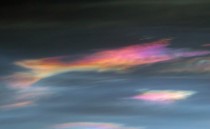By Lubos Motl, the Reference Frame
Radiative cooling (and warming) isn’t a key effect: a piece of the man-made climate change “lore” is shaken
This particular paper which may have isolated a major mistake in the would-be mainstream “lore” of the climate science - and in all the climate models - hasn’t gotten a sufficient amount of attention in the climate blogosphere. An article by The Hockey Schtick at the end of April and The Orange Punch yesterday are two exceptions.

A polar stratospheric cloud.
We’re talking about a paper in Atmospheric Chemistry and Physics that studied the conditions under which the clouds form in an upper layer of the atmosphere above the Arctic (the stratosphere):
On the linkage between tropospheric and polar stratospheric clouds in the Arctic as observed by space-borne lidar (PDF full text for free) If you need to know, a lidar is a radar that is emitting light waves instead of radio waves but it still looks at the reflected ones. For the same reason, a wadar is a garden hose.
The four authors, P. Achtert, M. Karlsson Andersson, F. Khosrawi, and J. Gumbel of Stockholm, actually try to do some proper science i.e. compare the predictions by various a priori possible theories/answers/hypothesis/explanations with the observations (instead of, for example, inventing interpretations of phenomena - arbitrarily contrived interpretations - that are compatible with a predetermined belief: I hope that 97%-98% of the “climate scientists” will appreciate my description of their corrupt work).
What did they find?
They found out that most of the Arctic polar stratospheric clouds (PSCs) are linked with the tropospheric clouds that are underneath, especially with the deep-tropospheric clouds. So far so good. However, they also calculated the correlation coefficient between the occurrence of the PSCs and the top temperature of the tropospheric clouds beneath them.
They found no correlation!
What does it imply? Let me copy the last sentence of the abstract:
Thus, our findings suggest that Arctic PSC formation is connected to adiabatic cooling, i.e. dynamic effects rather than radiative cooling.
The global warming climate models predict that the troposphere is warming - there’s a hot spot in it - and the stratosphere is cooling. Virtually all of these changes in these climate models are due to radiation.
In particular, the dominant “IPCC-endorsed” explanation of the cooling stratosphere is the following one: the tropospheric clouds absorb some thermal radiation emitted by the Earth’s surface. Consequently, this radiation doesn’t reach the stratosphere which is why the stratosphere is cooling. In effect, the lower-lying troposphere has stolen some heat (originally coming from the Earth’s surface or lower troposphere) from the stratosphere.
A cooling of the stratosphere is also a key change that is needed for the formation of the stratospheric clouds. You create droplets if you condense the water vapor. This can be most easily achieved by cooling of the air in the stratosphere: the relative humidity goes up.
However, if this hypothesis describing the reasons behind the cooling of the stratosphere - either in the short run or in the long run - were right, it would imply that the cooling is correlated with the temperature of the tropospheric clouds. The warmer they are, the more radiation they have “stolen” from the stratosphere. The data falsify this hypothesis.
This really means that the radiative flux - which energy in the form of radiation goes up or down and which places it is able to reach - isn’t a dominant factor deciding about things such as the changes of the stratospheric temperature, at least if we talk about the cooling that precedes the formation of the stratospheric clouds. That’s a big news because the global warming “paradigm” is all about the radiative flux. The greenhouse effect is all about the change of such radiative fluxes and they’re believed to be the primary quantities that decide about the temperature at various places.
But Nature doesn’t seem to work in this way.
Instead, the Swedish authors argue, the data support the theory that the formation of the polar stratospheric clouds - a sign of a cooling of the stratosphere - boils down to a cooling of another, non-radiative type: adiabatic cooling. Adiabatic cooling is a cooling caused by a decreasing pressure of some body of the air. This body “pushes” the surroundings and does mechanical work on the surroundings. By doing so, it loses some of its internal energy. Each molecule loses some kinetic energy which gets translated to the decrease of the temperature.
At least in this Arctic context, the tale about the climate can’t be described in the “IPCC-sponsored” way, “temperature change, radiation change, another temperature change, radiation change, and so on” but rather by “pressure change, temperature change, albedo change, pressure change, and so on”. The players in the new story are more diverse and different from the narrow list that is needed in models claiming that the absorption by a greenhouse gas may be the most important primary effect driving the atmosphere. There’s much more room for the pressure and humidity - and consequently for the internal variability of the atmosphere.
Of course, you won’t see similar papers discussed in the media. Such papers are actually learning something about what really matters in the atmosphere; but they don’t have the desired “societal implications” so the biased journalists just don’t write about such things.
Instead, they write about topics that are close to this fresh article at the DeSmogBlog. The website has renamed the “climate change denial movement” to something even more damning: they have added the most insulting two-word adjective that the climate change alarmists could think of. Now, the climate realists are known as the “free market climate change denial movement”. This gotta hurt! ![]()




